Development of Malaria Information Portal for Urban Lokoja, Nigeria
VerifiedAdded on 2020/12/10
|78
|18479
|491
Project
AI Summary
This project details the development of a Malaria Information Portal aimed at combating malaria in Urban Lokoja, Kogi State, Nigeria, during 2017-2018. The study investigates the environmental factors contributing to malaria prevalence, including waste management and breeding sites for mosquitoes. It explores the application of Information Technology (IT) to create a portal that provides information on malaria prevention, risk assessment, and mitigation strategies. The project incorporates field surveys, questionnaire-based data collection, and the design of a prototype portal. It also explores the use of Biogents mosquito traps as an effective method of mosquito control and data collection. The portal is designed to be a comprehensive resource for the community, offering insights into malaria, its prevention, and the latest technological advancements in combating the disease. The study includes detailed diagrams, figures, and use case methodologies to illustrate the portal's functionality and design.

Development of Malaria Information Portal in the fight
against Malaria in Urban Lokoja, Kogi State, Nigeria.
2017-18
Table of Contents
Dedication.........................................................................................................................................................ix
Acknowledgement..............................................................................................................................................x
Abstract.............................................................................................................................................................xi
Chapter 1............................................................................................................................................................1
Introduction....................................................................................................................................................1
against Malaria in Urban Lokoja, Kogi State, Nigeria.
2017-18
Table of Contents
Dedication.........................................................................................................................................................ix
Acknowledgement..............................................................................................................................................x
Abstract.............................................................................................................................................................xi
Chapter 1............................................................................................................................................................1
Introduction....................................................................................................................................................1
Paraphrase This Document
Need a fresh take? Get an instant paraphrase of this document with our AI Paraphraser
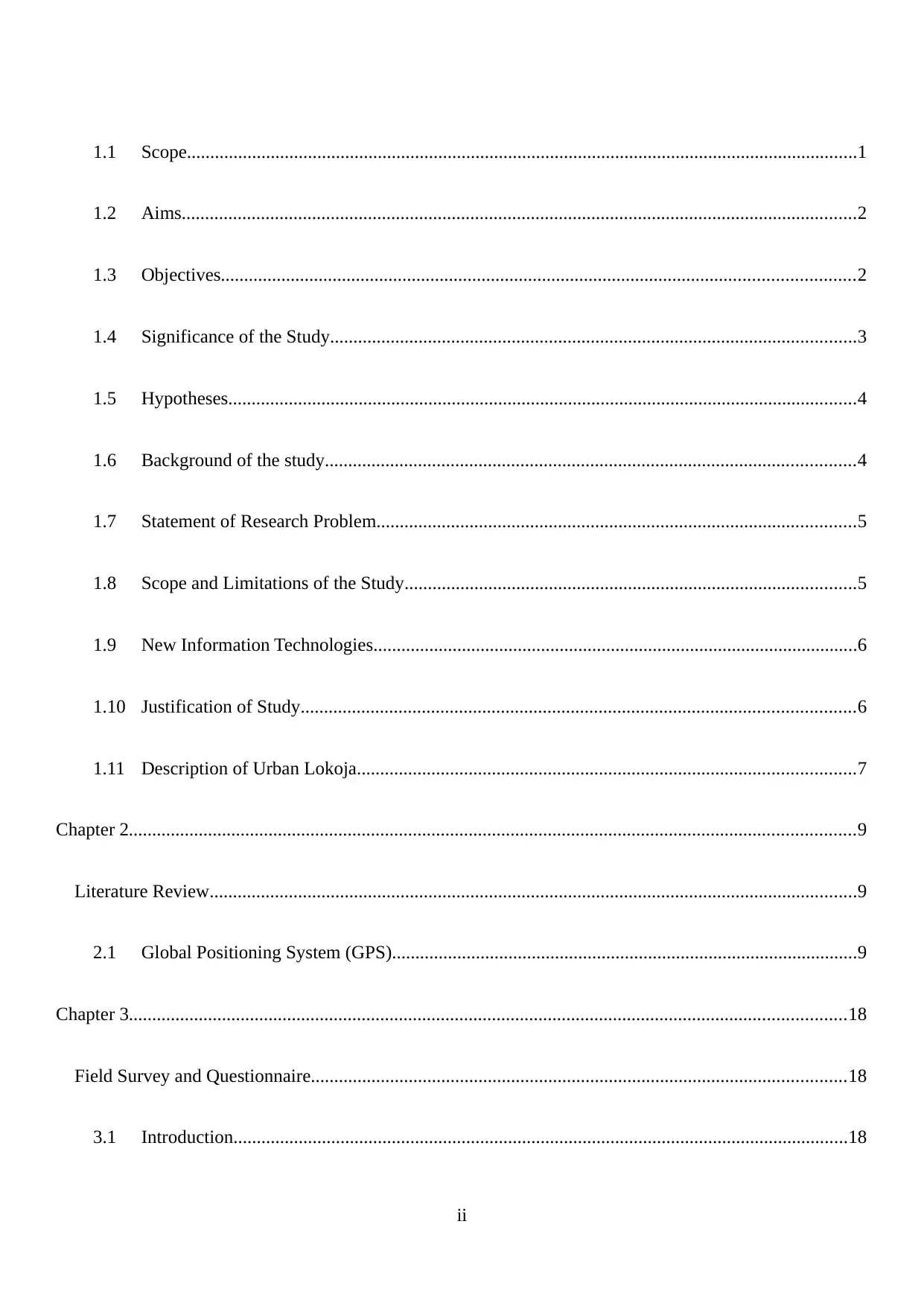
1.1 Scope................................................................................................................................................1
1.2 Aims.................................................................................................................................................2
1.3 Objectives........................................................................................................................................2
1.4 Significance of the Study.................................................................................................................3
1.5 Hypotheses.......................................................................................................................................4
1.6 Background of the study..................................................................................................................4
1.7 Statement of Research Problem.......................................................................................................5
1.8 Scope and Limitations of the Study.................................................................................................5
1.9 New Information Technologies........................................................................................................6
1.10 Justification of Study.......................................................................................................................6
1.11 Description of Urban Lokoja...........................................................................................................7
Chapter 2............................................................................................................................................................9
Literature Review...........................................................................................................................................9
2.1 Global Positioning System (GPS)....................................................................................................9
Chapter 3..........................................................................................................................................................18
Field Survey and Questionnaire...................................................................................................................18
3.1 Introduction....................................................................................................................................18
ii
1.2 Aims.................................................................................................................................................2
1.3 Objectives........................................................................................................................................2
1.4 Significance of the Study.................................................................................................................3
1.5 Hypotheses.......................................................................................................................................4
1.6 Background of the study..................................................................................................................4
1.7 Statement of Research Problem.......................................................................................................5
1.8 Scope and Limitations of the Study.................................................................................................5
1.9 New Information Technologies........................................................................................................6
1.10 Justification of Study.......................................................................................................................6
1.11 Description of Urban Lokoja...........................................................................................................7
Chapter 2............................................................................................................................................................9
Literature Review...........................................................................................................................................9
2.1 Global Positioning System (GPS)....................................................................................................9
Chapter 3..........................................................................................................................................................18
Field Survey and Questionnaire...................................................................................................................18
3.1 Introduction....................................................................................................................................18
ii
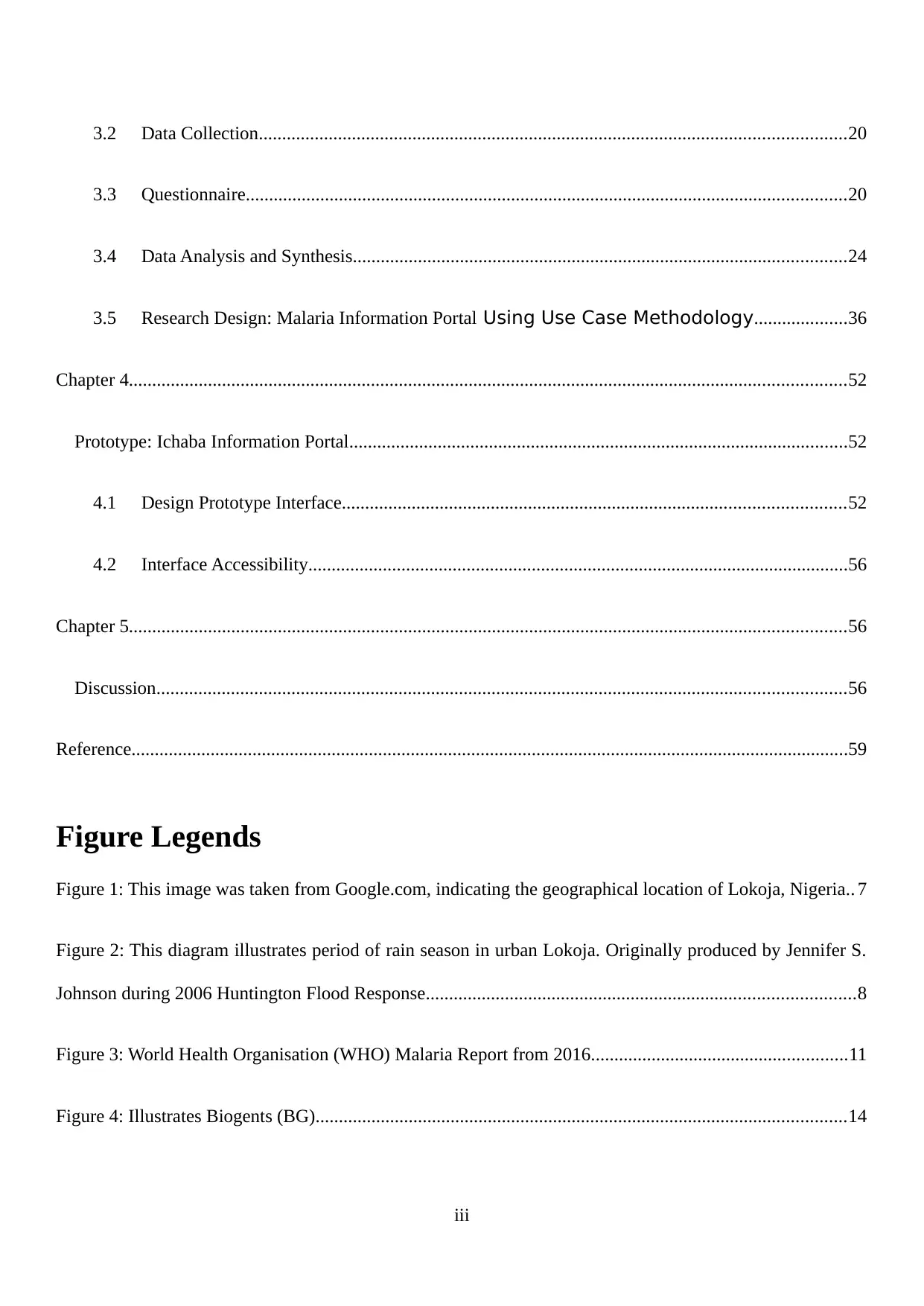
3.2 Data Collection..............................................................................................................................20
3.3 Questionnaire.................................................................................................................................20
3.4 Data Analysis and Synthesis..........................................................................................................24
3.5 Research Design: Malaria Information Portal Using Use Case Methodology....................36
Chapter 4..........................................................................................................................................................52
Prototype: Ichaba Information Portal...........................................................................................................52
4.1 Design Prototype Interface............................................................................................................52
4.2 Interface Accessibility....................................................................................................................56
Chapter 5..........................................................................................................................................................56
Discussion....................................................................................................................................................56
Reference..........................................................................................................................................................59
Figure Legends
Figure 1: This image was taken from Google.com, indicating the geographical location of Lokoja, Nigeria.. 7
Figure 2: This diagram illustrates period of rain season in urban Lokoja. Originally produced by Jennifer S.
Johnson during 2006 Huntington Flood Response............................................................................................8
Figure 3: World Health Organisation (WHO) Malaria Report from 2016.......................................................11
Figure 4: Illustrates Biogents (BG)..................................................................................................................14
iii
3.3 Questionnaire.................................................................................................................................20
3.4 Data Analysis and Synthesis..........................................................................................................24
3.5 Research Design: Malaria Information Portal Using Use Case Methodology....................36
Chapter 4..........................................................................................................................................................52
Prototype: Ichaba Information Portal...........................................................................................................52
4.1 Design Prototype Interface............................................................................................................52
4.2 Interface Accessibility....................................................................................................................56
Chapter 5..........................................................................................................................................................56
Discussion....................................................................................................................................................56
Reference..........................................................................................................................................................59
Figure Legends
Figure 1: This image was taken from Google.com, indicating the geographical location of Lokoja, Nigeria.. 7
Figure 2: This diagram illustrates period of rain season in urban Lokoja. Originally produced by Jennifer S.
Johnson during 2006 Huntington Flood Response............................................................................................8
Figure 3: World Health Organisation (WHO) Malaria Report from 2016.......................................................11
Figure 4: Illustrates Biogents (BG)..................................................................................................................14
iii
⊘ This is a preview!⊘
Do you want full access?
Subscribe today to unlock all pages.

Trusted by 1+ million students worldwide

Figure 5: Illustrates two week old flooded environment (taken in County of Fairfax, Virginia., USA).........15
Figure 6: Contains Image from Huntington Flood Response 2006.................................................................16
Figure 7: Shows more designs of Biogents mosquito traps.............................................................................16
Figure 8: Page 1 of the Environmental & Malaria Questionnaire form filled out by the participants in
Nigeria..............................................................................................................................................................21
Figure 9: Page 2 of the Environmental & Malaria Questionnaire form filled out by the participants in
Nigeria..............................................................................................................................................................22
Figure 10: Page 3 of the Environmental & Malaria Questionnaire form filled out by the participants in
Nigeria..............................................................................................................................................................23
Figure 11: Illustrates the percentage of participants of the questionnaire survey both male and female........24
Figure 12: Pie chart demonstrates accurate percentage of the participants.....................................................24
Figure 13: This illustrates the percentage of rubbish collected and those not collected..................................26
Figure 14: Pie Chart is used to calculate the percentage of figure 30 of the rubbish distribution...................27
Figure 15: Number of females with mobile and internet access......................................................................28
Figure 16: Number of males with mobile and internet access.........................................................................28
Figure 17: This image was recorded at Lokoja urban city during field survey showing the road which
appeared to have been abandoned, yet in use by motorists..............................................................................29
Figure 18: This image was also recorded during field survey at urban Lokoja indicating a state of bad road
but at different location....................................................................................................................................29
iv
Figure 6: Contains Image from Huntington Flood Response 2006.................................................................16
Figure 7: Shows more designs of Biogents mosquito traps.............................................................................16
Figure 8: Page 1 of the Environmental & Malaria Questionnaire form filled out by the participants in
Nigeria..............................................................................................................................................................21
Figure 9: Page 2 of the Environmental & Malaria Questionnaire form filled out by the participants in
Nigeria..............................................................................................................................................................22
Figure 10: Page 3 of the Environmental & Malaria Questionnaire form filled out by the participants in
Nigeria..............................................................................................................................................................23
Figure 11: Illustrates the percentage of participants of the questionnaire survey both male and female........24
Figure 12: Pie chart demonstrates accurate percentage of the participants.....................................................24
Figure 13: This illustrates the percentage of rubbish collected and those not collected..................................26
Figure 14: Pie Chart is used to calculate the percentage of figure 30 of the rubbish distribution...................27
Figure 15: Number of females with mobile and internet access......................................................................28
Figure 16: Number of males with mobile and internet access.........................................................................28
Figure 17: This image was recorded at Lokoja urban city during field survey showing the road which
appeared to have been abandoned, yet in use by motorists..............................................................................29
Figure 18: This image was also recorded during field survey at urban Lokoja indicating a state of bad road
but at different location....................................................................................................................................29
iv
Paraphrase This Document
Need a fresh take? Get an instant paraphrase of this document with our AI Paraphraser

Figure 19: Indicates an abandoned waste container overdue for collection....................................................30
Figure 20: The above image illustrates a dumping site closer to a market during a field survey, which can be
used by mosquitoes during the rainy season to lay eggs..................................................................................31
Figure 21: This image was taken during field survey and depicts a road layout within urban Lokoja. As it can
be seen, the road side was also used as a dumping ground..............................................................................31
Figure 22: This image was captured from Google.com taken in the early 1950s............................................33
Figure 23: This image was captured from Google.com taken in the early 1950s............................................33
Figure 24: This image was taken from Google.com........................................................................................34
Figure 25: This image was taken from Google.com, which reflects persistent search for modern
development.....................................................................................................................................................35
Figure 26: This image was taken from Google.com, which reflects persistent search for modern
development, and provision for drainage and sewage system.........................................................................35
Figure 27: Login Page. (This diagram is drawn using the knowledge gained from User Centre Designed
(UCD) Assignment 2: Design Report involving teamwork: Sam, Timothy, Dan & Ayo.................................40
Figure 28: Illustrates interface diagram of malaria information portal (This diagram is drawn using the
knowledge gained from User Centre Designed (UCD) Assignment 2: Design Report involving teamwork:
Sam, Timothy, Dan & Ayo)..............................................................................................................................41
Figure 29: This diagram illustrates apps to create malaria report (This diagram is drawn using the knowledge
gained from User Centre Designed (UCD) Assignment 2: Design Report involving teamwork: Sam,
Timothy, Dan & Ayo).......................................................................................................................................42
v
Figure 20: The above image illustrates a dumping site closer to a market during a field survey, which can be
used by mosquitoes during the rainy season to lay eggs..................................................................................31
Figure 21: This image was taken during field survey and depicts a road layout within urban Lokoja. As it can
be seen, the road side was also used as a dumping ground..............................................................................31
Figure 22: This image was captured from Google.com taken in the early 1950s............................................33
Figure 23: This image was captured from Google.com taken in the early 1950s............................................33
Figure 24: This image was taken from Google.com........................................................................................34
Figure 25: This image was taken from Google.com, which reflects persistent search for modern
development.....................................................................................................................................................35
Figure 26: This image was taken from Google.com, which reflects persistent search for modern
development, and provision for drainage and sewage system.........................................................................35
Figure 27: Login Page. (This diagram is drawn using the knowledge gained from User Centre Designed
(UCD) Assignment 2: Design Report involving teamwork: Sam, Timothy, Dan & Ayo.................................40
Figure 28: Illustrates interface diagram of malaria information portal (This diagram is drawn using the
knowledge gained from User Centre Designed (UCD) Assignment 2: Design Report involving teamwork:
Sam, Timothy, Dan & Ayo)..............................................................................................................................41
Figure 29: This diagram illustrates apps to create malaria report (This diagram is drawn using the knowledge
gained from User Centre Designed (UCD) Assignment 2: Design Report involving teamwork: Sam,
Timothy, Dan & Ayo).......................................................................................................................................42
v

Figure 30: This diagram contains “Use Case Diagram” for Malaria Portal. (The use case diagram is drawn
using the knowledge gained from the module “System Design Technique”)..................................................42
Figure 31: Contains use case description for malaria portal. (The use case description diagram is drawn
using the knowledge gained from the module “System Design Technique”)..................................................43
Figure 32: Contains use case diagram for adding new report. (The use case diagram is drawn using the
knowledge gained from the module “System Design Technique”).................................................................44
Figure 33: Contains activity diagram narrating the sequence of the objects that enable users to create new
report in the portal. (The activity diagram is drawn using the knowledge gained from the module “System
Design Technique”)..........................................................................................................................................44
Figure 34: Contains use case for editing report. (The use case diagram is drawn using the knowledge gained
from the module “System Design Technique”)................................................................................................45
Figure 35: This diagram shows edit page. (The activity diagram is drawn using the knowledge gained from
the module “System Design Technique”)........................................................................................................45
Figure 36: Contains use case for sharing new report. (The use case diagram is drawn using the knowledge
gained from the module “System Design Technique”)....................................................................................46
Figure 37: This shows sharing page of malaria news. (The use case diagram is drawn using the knowledge
gained from the module “System Design Technique”)....................................................................................46
Figure 38: Contains sequence diagram. (The sequence diagram is drawn using the knowledge gained from
the module “System Design Technique”)........................................................................................................47
Figure 39: Shows the state machine diagram. (The state machine diagram is drawn using the knowledge
gained from the module “System Design Technique”)....................................................................................47
vi
using the knowledge gained from the module “System Design Technique”)..................................................42
Figure 31: Contains use case description for malaria portal. (The use case description diagram is drawn
using the knowledge gained from the module “System Design Technique”)..................................................43
Figure 32: Contains use case diagram for adding new report. (The use case diagram is drawn using the
knowledge gained from the module “System Design Technique”).................................................................44
Figure 33: Contains activity diagram narrating the sequence of the objects that enable users to create new
report in the portal. (The activity diagram is drawn using the knowledge gained from the module “System
Design Technique”)..........................................................................................................................................44
Figure 34: Contains use case for editing report. (The use case diagram is drawn using the knowledge gained
from the module “System Design Technique”)................................................................................................45
Figure 35: This diagram shows edit page. (The activity diagram is drawn using the knowledge gained from
the module “System Design Technique”)........................................................................................................45
Figure 36: Contains use case for sharing new report. (The use case diagram is drawn using the knowledge
gained from the module “System Design Technique”)....................................................................................46
Figure 37: This shows sharing page of malaria news. (The use case diagram is drawn using the knowledge
gained from the module “System Design Technique”)....................................................................................46
Figure 38: Contains sequence diagram. (The sequence diagram is drawn using the knowledge gained from
the module “System Design Technique”)........................................................................................................47
Figure 39: Shows the state machine diagram. (The state machine diagram is drawn using the knowledge
gained from the module “System Design Technique”)....................................................................................47
vi
⊘ This is a preview!⊘
Do you want full access?
Subscribe today to unlock all pages.

Trusted by 1+ million students worldwide
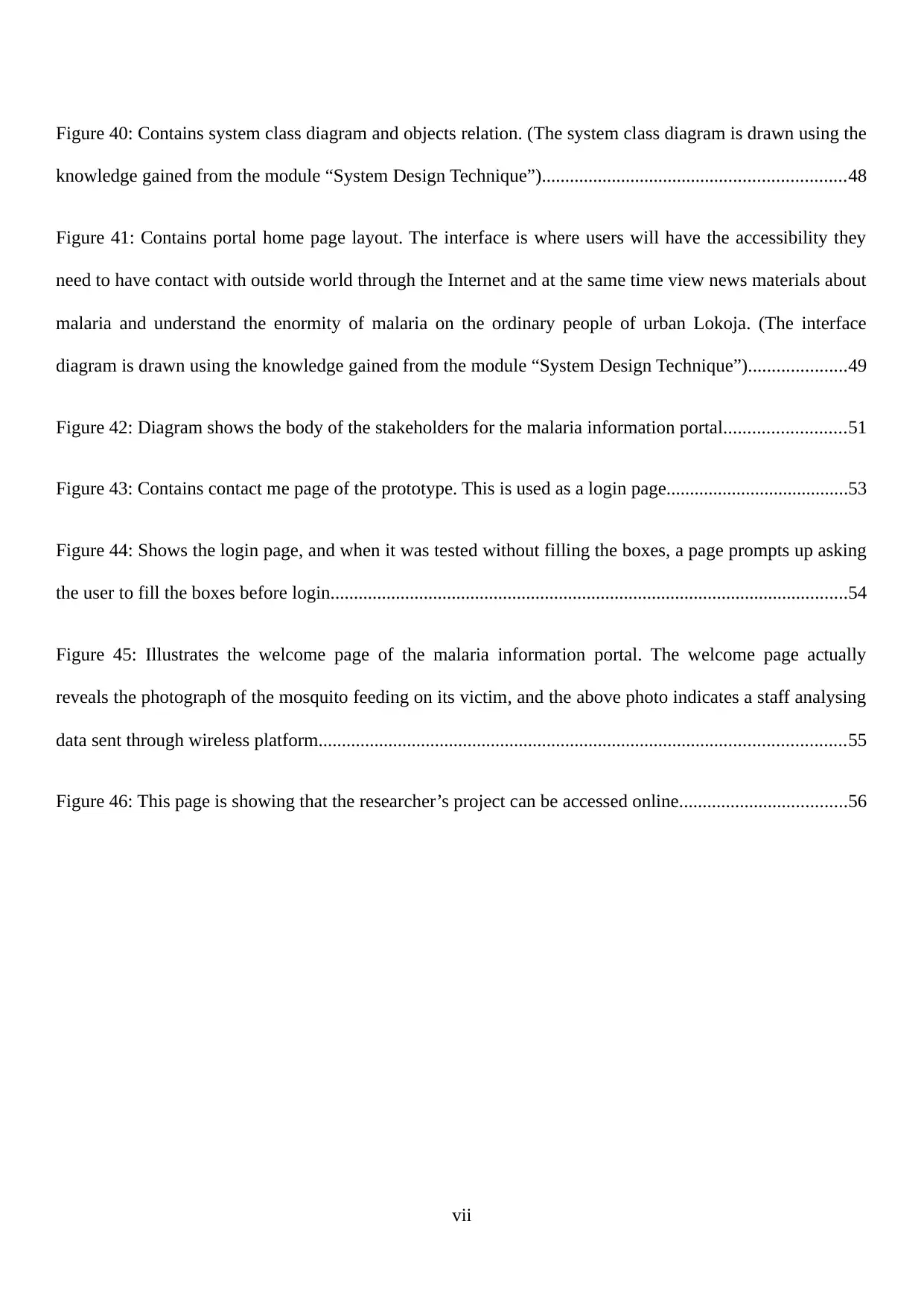
Figure 40: Contains system class diagram and objects relation. (The system class diagram is drawn using the
knowledge gained from the module “System Design Technique”).................................................................48
Figure 41: Contains portal home page layout. The interface is where users will have the accessibility they
need to have contact with outside world through the Internet and at the same time view news materials about
malaria and understand the enormity of malaria on the ordinary people of urban Lokoja. (The interface
diagram is drawn using the knowledge gained from the module “System Design Technique”).....................49
Figure 42: Diagram shows the body of the stakeholders for the malaria information portal..........................51
Figure 43: Contains contact me page of the prototype. This is used as a login page.......................................53
Figure 44: Shows the login page, and when it was tested without filling the boxes, a page prompts up asking
the user to fill the boxes before login...............................................................................................................54
Figure 45: Illustrates the welcome page of the malaria information portal. The welcome page actually
reveals the photograph of the mosquito feeding on its victim, and the above photo indicates a staff analysing
data sent through wireless platform.................................................................................................................55
Figure 46: This page is showing that the researcher’s project can be accessed online....................................56
vii
knowledge gained from the module “System Design Technique”).................................................................48
Figure 41: Contains portal home page layout. The interface is where users will have the accessibility they
need to have contact with outside world through the Internet and at the same time view news materials about
malaria and understand the enormity of malaria on the ordinary people of urban Lokoja. (The interface
diagram is drawn using the knowledge gained from the module “System Design Technique”).....................49
Figure 42: Diagram shows the body of the stakeholders for the malaria information portal..........................51
Figure 43: Contains contact me page of the prototype. This is used as a login page.......................................53
Figure 44: Shows the login page, and when it was tested without filling the boxes, a page prompts up asking
the user to fill the boxes before login...............................................................................................................54
Figure 45: Illustrates the welcome page of the malaria information portal. The welcome page actually
reveals the photograph of the mosquito feeding on its victim, and the above photo indicates a staff analysing
data sent through wireless platform.................................................................................................................55
Figure 46: This page is showing that the researcher’s project can be accessed online....................................56
vii
Paraphrase This Document
Need a fresh take? Get an instant paraphrase of this document with our AI Paraphraser

Table Legends
Table 1: Participants’ gender both male and female........................................................................................25
Table 2: Participants’ age brackets both male and female................................................................................25
Table 3: Participants’ employment status both male and female.....................................................................25
Table 4: Contains the order by which wastes were being disposed of without following proper procedures,
and without mini-waste bin provided to every household by the State Government......................................25
viii
Table 1: Participants’ gender both male and female........................................................................................25
Table 2: Participants’ age brackets both male and female................................................................................25
Table 3: Participants’ employment status both male and female.....................................................................25
Table 4: Contains the order by which wastes were being disposed of without following proper procedures,
and without mini-waste bin provided to every household by the State Government......................................25
viii
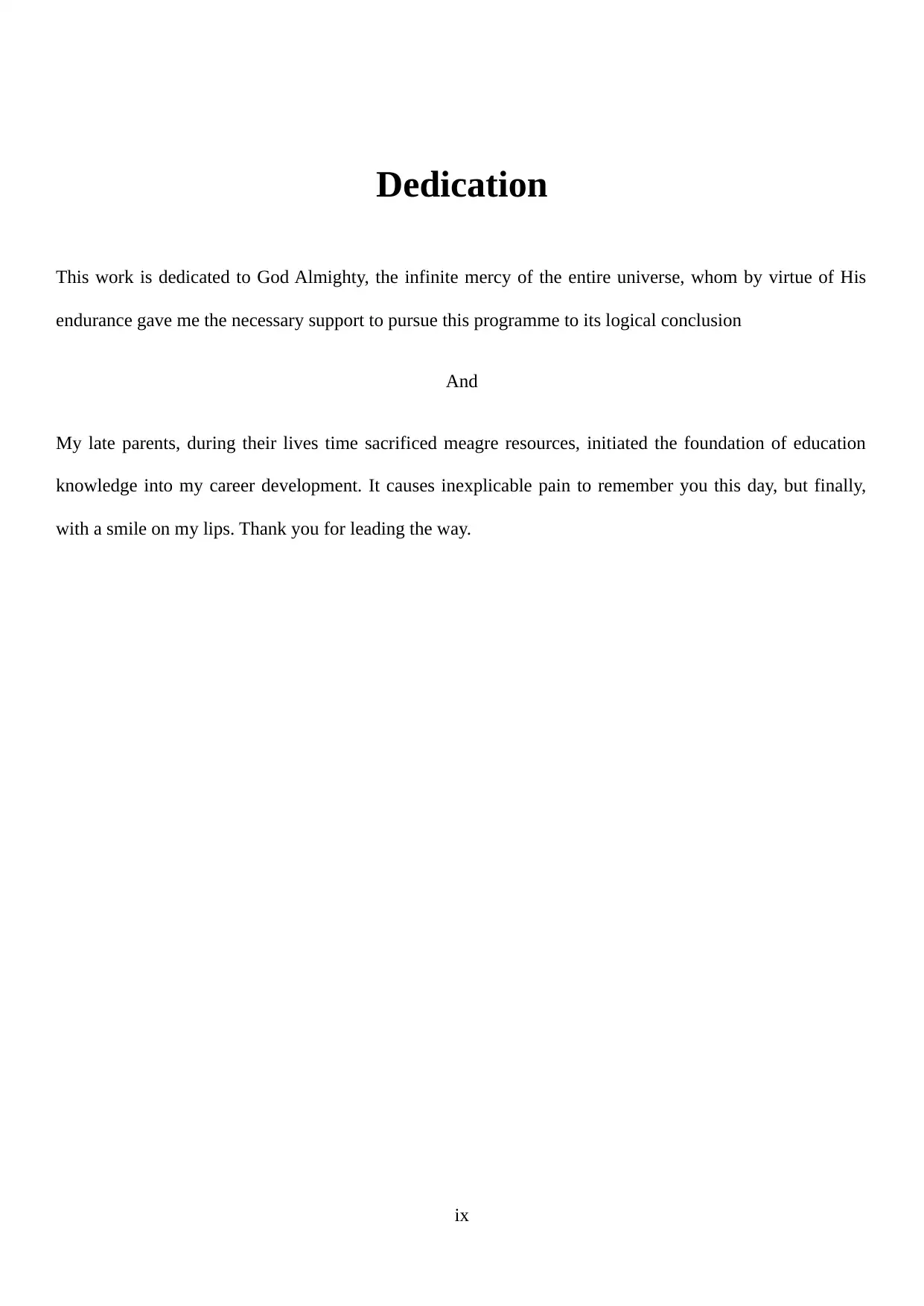
Dedication
This work is dedicated to God Almighty, the infinite mercy of the entire universe, whom by virtue of His
endurance gave me the necessary support to pursue this programme to its logical conclusion
And
My late parents, during their lives time sacrificed meagre resources, initiated the foundation of education
knowledge into my career development. It causes inexplicable pain to remember you this day, but finally,
with a smile on my lips. Thank you for leading the way.
ix
This work is dedicated to God Almighty, the infinite mercy of the entire universe, whom by virtue of His
endurance gave me the necessary support to pursue this programme to its logical conclusion
And
My late parents, during their lives time sacrificed meagre resources, initiated the foundation of education
knowledge into my career development. It causes inexplicable pain to remember you this day, but finally,
with a smile on my lips. Thank you for leading the way.
ix
⊘ This is a preview!⊘
Do you want full access?
Subscribe today to unlock all pages.

Trusted by 1+ million students worldwide
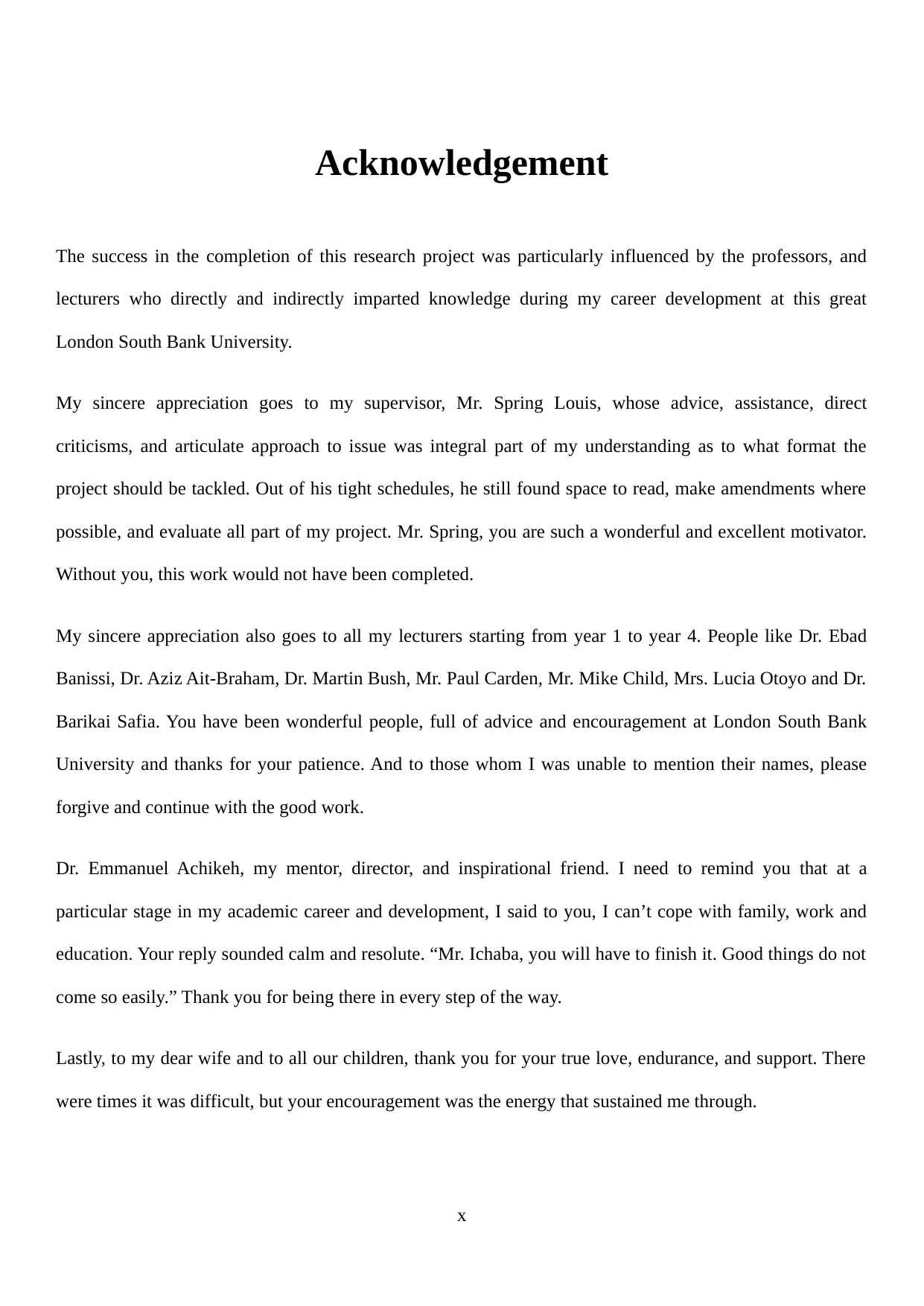
Acknowledgement
The success in the completion of this research project was particularly influenced by the professors, and
lecturers who directly and indirectly imparted knowledge during my career development at this great
London South Bank University.
My sincere appreciation goes to my supervisor, Mr. Spring Louis, whose advice, assistance, direct
criticisms, and articulate approach to issue was integral part of my understanding as to what format the
project should be tackled. Out of his tight schedules, he still found space to read, make amendments where
possible, and evaluate all part of my project. Mr. Spring, you are such a wonderful and excellent motivator.
Without you, this work would not have been completed.
My sincere appreciation also goes to all my lecturers starting from year 1 to year 4. People like Dr. Ebad
Banissi, Dr. Aziz Ait-Braham, Dr. Martin Bush, Mr. Paul Carden, Mr. Mike Child, Mrs. Lucia Otoyo and Dr.
Barikai Safia. You have been wonderful people, full of advice and encouragement at London South Bank
University and thanks for your patience. And to those whom I was unable to mention their names, please
forgive and continue with the good work.
Dr. Emmanuel Achikeh, my mentor, director, and inspirational friend. I need to remind you that at a
particular stage in my academic career and development, I said to you, I can’t cope with family, work and
education. Your reply sounded calm and resolute. “Mr. Ichaba, you will have to finish it. Good things do not
come so easily.” Thank you for being there in every step of the way.
Lastly, to my dear wife and to all our children, thank you for your true love, endurance, and support. There
were times it was difficult, but your encouragement was the energy that sustained me through.
x
The success in the completion of this research project was particularly influenced by the professors, and
lecturers who directly and indirectly imparted knowledge during my career development at this great
London South Bank University.
My sincere appreciation goes to my supervisor, Mr. Spring Louis, whose advice, assistance, direct
criticisms, and articulate approach to issue was integral part of my understanding as to what format the
project should be tackled. Out of his tight schedules, he still found space to read, make amendments where
possible, and evaluate all part of my project. Mr. Spring, you are such a wonderful and excellent motivator.
Without you, this work would not have been completed.
My sincere appreciation also goes to all my lecturers starting from year 1 to year 4. People like Dr. Ebad
Banissi, Dr. Aziz Ait-Braham, Dr. Martin Bush, Mr. Paul Carden, Mr. Mike Child, Mrs. Lucia Otoyo and Dr.
Barikai Safia. You have been wonderful people, full of advice and encouragement at London South Bank
University and thanks for your patience. And to those whom I was unable to mention their names, please
forgive and continue with the good work.
Dr. Emmanuel Achikeh, my mentor, director, and inspirational friend. I need to remind you that at a
particular stage in my academic career and development, I said to you, I can’t cope with family, work and
education. Your reply sounded calm and resolute. “Mr. Ichaba, you will have to finish it. Good things do not
come so easily.” Thank you for being there in every step of the way.
Lastly, to my dear wife and to all our children, thank you for your true love, endurance, and support. There
were times it was difficult, but your encouragement was the energy that sustained me through.
x
Paraphrase This Document
Need a fresh take? Get an instant paraphrase of this document with our AI Paraphraser
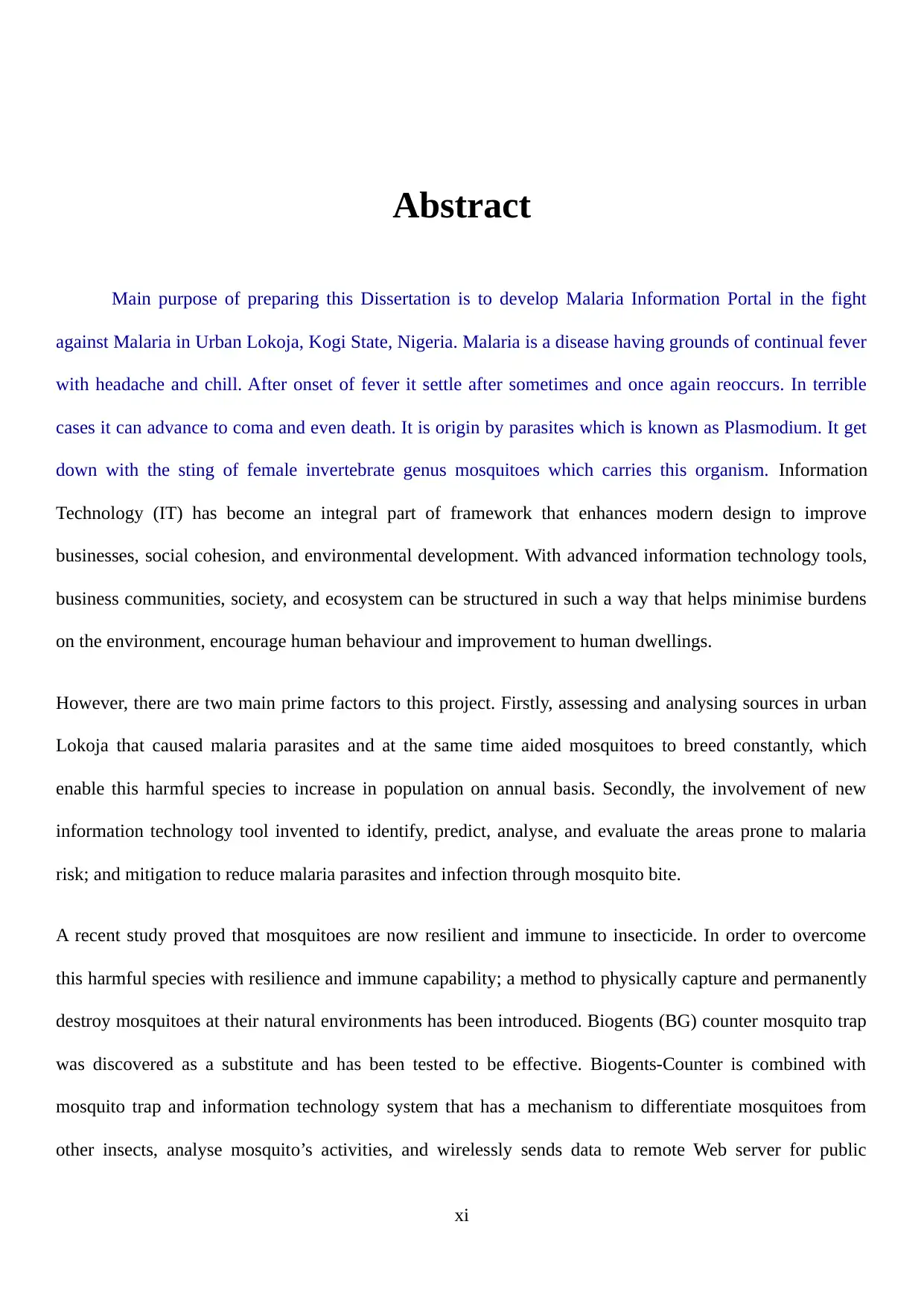
Abstract
Main purpose of preparing this Dissertation is to develop Malaria Information Portal in the fight
against Malaria in Urban Lokoja, Kogi State, Nigeria. Malaria is a disease having grounds of continual fever
with headache and chill. After onset of fever it settle after sometimes and once again reoccurs. In terrible
cases it can advance to coma and even death. It is origin by parasites which is known as Plasmodium. It get
down with the sting of female invertebrate genus mosquitoes which carries this organism. Information
Technology (IT) has become an integral part of framework that enhances modern design to improve
businesses, social cohesion, and environmental development. With advanced information technology tools,
business communities, society, and ecosystem can be structured in such a way that helps minimise burdens
on the environment, encourage human behaviour and improvement to human dwellings.
However, there are two main prime factors to this project. Firstly, assessing and analysing sources in urban
Lokoja that caused malaria parasites and at the same time aided mosquitoes to breed constantly, which
enable this harmful species to increase in population on annual basis. Secondly, the involvement of new
information technology tool invented to identify, predict, analyse, and evaluate the areas prone to malaria
risk; and mitigation to reduce malaria parasites and infection through mosquito bite.
A recent study proved that mosquitoes are now resilient and immune to insecticide. In order to overcome
this harmful species with resilience and immune capability; a method to physically capture and permanently
destroy mosquitoes at their natural environments has been introduced. Biogents (BG) counter mosquito trap
was discovered as a substitute and has been tested to be effective. Biogents-Counter is combined with
mosquito trap and information technology system that has a mechanism to differentiate mosquitoes from
other insects, analyse mosquito’s activities, and wirelessly sends data to remote Web server for public
xi
Main purpose of preparing this Dissertation is to develop Malaria Information Portal in the fight
against Malaria in Urban Lokoja, Kogi State, Nigeria. Malaria is a disease having grounds of continual fever
with headache and chill. After onset of fever it settle after sometimes and once again reoccurs. In terrible
cases it can advance to coma and even death. It is origin by parasites which is known as Plasmodium. It get
down with the sting of female invertebrate genus mosquitoes which carries this organism. Information
Technology (IT) has become an integral part of framework that enhances modern design to improve
businesses, social cohesion, and environmental development. With advanced information technology tools,
business communities, society, and ecosystem can be structured in such a way that helps minimise burdens
on the environment, encourage human behaviour and improvement to human dwellings.
However, there are two main prime factors to this project. Firstly, assessing and analysing sources in urban
Lokoja that caused malaria parasites and at the same time aided mosquitoes to breed constantly, which
enable this harmful species to increase in population on annual basis. Secondly, the involvement of new
information technology tool invented to identify, predict, analyse, and evaluate the areas prone to malaria
risk; and mitigation to reduce malaria parasites and infection through mosquito bite.
A recent study proved that mosquitoes are now resilient and immune to insecticide. In order to overcome
this harmful species with resilience and immune capability; a method to physically capture and permanently
destroy mosquitoes at their natural environments has been introduced. Biogents (BG) counter mosquito trap
was discovered as a substitute and has been tested to be effective. Biogents-Counter is combined with
mosquito trap and information technology system that has a mechanism to differentiate mosquitoes from
other insects, analyse mosquito’s activities, and wirelessly sends data to remote Web server for public
xi
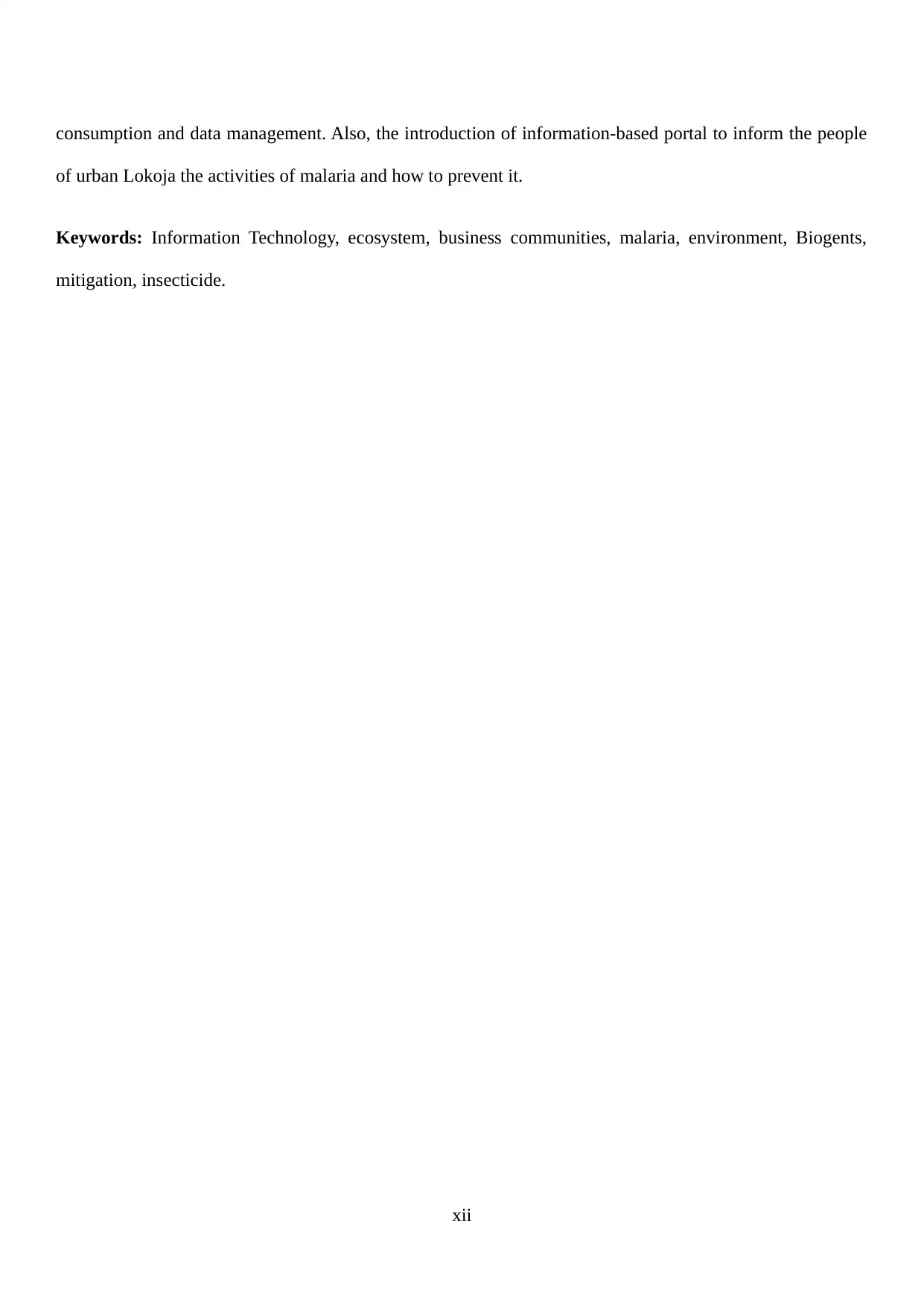
consumption and data management. Also, the introduction of information-based portal to inform the people
of urban Lokoja the activities of malaria and how to prevent it.
Keywords: Information Technology, ecosystem, business communities, malaria, environment, Biogents,
mitigation, insecticide.
xii
of urban Lokoja the activities of malaria and how to prevent it.
Keywords: Information Technology, ecosystem, business communities, malaria, environment, Biogents,
mitigation, insecticide.
xii
⊘ This is a preview!⊘
Do you want full access?
Subscribe today to unlock all pages.

Trusted by 1+ million students worldwide
1 out of 78
Your All-in-One AI-Powered Toolkit for Academic Success.
+13062052269
info@desklib.com
Available 24*7 on WhatsApp / Email
![[object Object]](/_next/static/media/star-bottom.7253800d.svg)
Unlock your academic potential
Copyright © 2020–2025 A2Z Services. All Rights Reserved. Developed and managed by ZUCOL.